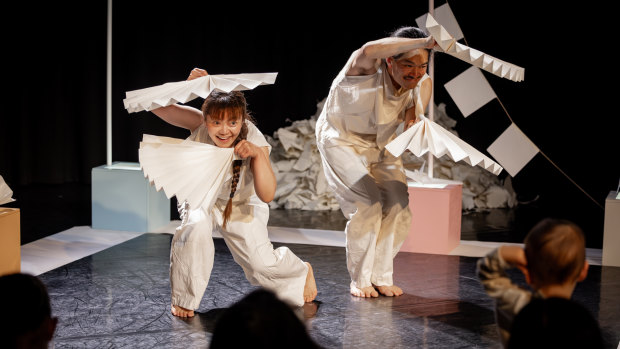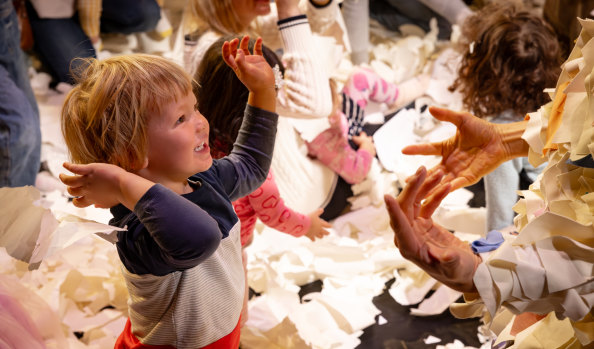An imaginary world that is a delight for fans of Japanese playfulness
By Chantal Nguyen and Harriet Cunningham
DANCE
Club Origami
★★★★
Neilson Studio at Sydney Dance Company, July 10
(Until July 20)
Reviewed by CHANTAL NGUYEN (with ANGUS and LACHLAN MASCARENHAS)
My co-reviewer Angus (aged 5) observes my other co-reviewer, his brother Lachlan (aged 7), kick off his shoes for Club Origami, Sydney Dance Company’s first season for the 5 years and under crowd.

In Club Origami, Makiko Aoyama, left, and Takeshi Matsumoto, create an imaginary world of paper animals and quirky shapes.Credit: Jacquie Manning
It features the British-Asian dance collective Seven Circles, founded by choreographer and dance therapist Takeshi Matsumoto, known for his dance therapy initiatives with children, refugees, natural disaster victims and people with disabilities. Club Origami promises immersive paper-based fun: “Rip, fold and scrumple!” reads its website.
The kids press towards the doors, where Matsumoto and co-creator Makiko Aoyama hand out white paper squares. They are dressed like origami themselves – white costumes with soft, papery folds. Gus enthusiastically shapes his square into a replica of a giant whistle. Lachy, with his extra two years of fine motor skill development, produces a diligently straight-edged origami piece.
Older than the target audience, Lachy is here because of school holidays – he benevolently tolerates the babies crawling around him. Matsumoto and Aoyama receive the kids’ creations, then everyone piles around the stage where co-creator Robert Howat stands at a xylophone synthesiser, producing ribbons of shimmering chords.
What follows is 45 minutes of gentle, danced whimsy. It will delight any fan of a particular Japanese aesthetic: thoughtful, clean and playful. Matsumoto and Aoyama create an imaginary world of paper animals and quirky shapes – origami penguins, giant fans and a hat that is possibly a cat. They bring out the kids’ origami and replicate the shapes with their bodies.
Gus’s whistle inspires a particularly long improvised dance sequence. Exclamations of recognition abound. “I thought ‘Oh cool! My one! I’m part of the performance!’” Lachy explains.
Some children grow fidgety – until Aoyama runs out with a glowing light, like a firefly. Contention breaks out among the 3- to 5-year-old group. Is it a fire? No, it’s a light bulb!
Club Origami crescendos as Matsumoto wraps Aoyama in reams of rolled paper, lifting her onto his shoulders to morph into a giant paper monster. She dives headfirst into a mountain of torn paper. The audience gasps. Then they’re invited to join – shrieks of delight ensue.

Club Origami found an appreciative young audience.Credit: Jacquie Manning
Gus and Lachy’s dad, Viren, notes it’s a diverse age group to entertain. But observing the audience rolling happily in the papery snowstorm, he nods approvingly. “This is the universal,” he says. “Ripping stuff up and throwing it around. You can’t go wrong.”
Lachy squeals “I’m in heaven here!” as he runs past.
CLASSICAL MUSIC
Sydney Symphony Orchestra: Saint-Saëns’ Organ Symphony
★★★½
Opera House Concert Hall, July 10
Reviewed by Harriet Cunningham
The grand organ of the Sydney Opera House Concert Hall is very patient. It waits its turn, the serried ranks of silver pipes which line the back of the hall – sometimes silent for years, just waiting, counting bars rest, until it is time. Last night French organist Olivier Latry woke the sleeping giant.
The giant was grumpy in the opening of Poulenc’s Organ Concerto, which lurches from a stern Bach-like harmony to a scrunch of dissonance, but Latry soon charmed the beast. Under the baton of Stéphane Denève, the concerto unfolded in all its odd glory, bouncing between celestial calm, stentorian dread and fairground antics.
Latry’s selection of voices for the concerto leaned into the dramatic contrasts, enjoying sudden mood changes and unapologetically blunt outbursts. Against this mercurial backdrop the strings of the Sydney Symphony Orchestra, led by associate concertmaster Harry Bennetts, shone through with their warm and consistent ensemble sound. As an encore, Latry raced against himself in a breathless scramble through Bach’s E major Partita. He won.
Camille Saint-Saëns’ Symphony No. 3 in G minor, Op. 78, known as the Organ Symphony, is etched on many a memory because of its use in the 1995 movie Babe. In this performance, Denève brought out the work’s dense collage of musical memories: a rasping Dies Irae from the brass, an impassioned Pathetique from the strings and, of course, the magisterial Bach chorale which frames the final movement.
These became distinctive waypoints on a somewhat foggy journey. While rhythmic instabilities were, much of the time, down to Saint-Saëns’ unrelenting syncopation, I missed the colour and clarity of the Poulenc. The exception was the central slow movement, in which organ and strings achieved some magical pianissimos as they wove spindly lines into a seamless whole.
The concert opened with the Australian premiere of Flammenschrift (rough translation, ‘written in flames’) by French composer Guillaume Connesson. A torrid 10 minutes of rage, it was a showcase for explosive orchestral energy and commitment.
More performances on July 11 to 13.
Find out the next TV, streaming series and movies to add to your must-sees. Get The Watchlist delivered every Thursday.